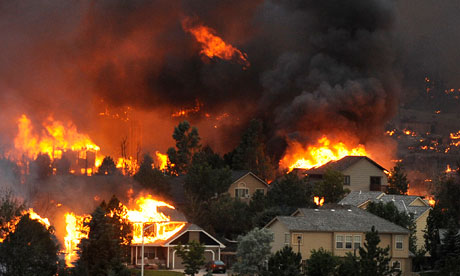We Need a Forest Policy Fix; it is Long Overdue - Part I
By: Amos S. Eno
Posted on:04/23/2013 Updated:05/07/2013Resources First Foundation works hard to partner with the United States Forest Service to save America's working forests.
Forests across the US are in trouble: They face three apocalyptic horsemen; (1) fire danger driven by five decades of environmentally degenerative forest management policies that have turned our national forests into conflagration enclaves; (2) forest fragmentation, particularly around our major metropolitan areas driven by the simultaneous pressures of expanding development and an aging forest ownership population that is approaching 70 years average nationwide; (3) the market penetration of forest stewardship management plans and cooperative forestry programs is de minimis to date.
Resources First Foundation offers a nationwide information platform and an increasing array of state conservation centers in critical forestry states that addresses each of these three issues and provides perhaps the most important remedial stimulant to forestry reform practices in the country. Allow us to amplify the problems facing USFS.
(1) Fire danger: “Across the west we are experiencing one of the region’s worst fire seasons in decades…
 42,933 wildfires have been reported in the U.S. this season burning 6.4 million acres.”(Jessie Bonner, Associated Press 15 Aug., 2012). Fires are not limited to western states; the New Jersey Pinelands hosts an unprecedented fuel load today that is just awaiting the next match and or lightning strike. It takes seven consecutive permits to cut a tree in the Pinelands, making forest management a laughable and prohibitive exercise. The fire potential in New Jersey where forests abut suburban developments will be catastrophic.
42,933 wildfires have been reported in the U.S. this season burning 6.4 million acres.”(Jessie Bonner, Associated Press 15 Aug., 2012). Fires are not limited to western states; the New Jersey Pinelands hosts an unprecedented fuel load today that is just awaiting the next match and or lightning strike. It takes seven consecutive permits to cut a tree in the Pinelands, making forest management a laughable and prohibitive exercise. The fire potential in New Jersey where forests abut suburban developments will be catastrophic.
The Waldo County wildfire destroyed hundreds of homes in Colorado Springs on June 26, 2012.
Photo Credit: Helen H. Richardson/AP
Why have we come to this point? Professor Thomas Straka, faculty of forestry, Clemson University, S.C. succinctly identifies the problem source. In his letter to Wall St Journal (25 Sept. 2012), he wrote, “foresters have long warned about wildfires, insect infestations and disease problems in poorly managed national forests. Starting in the 1960s and 70s environmental pressure caused the Forest Service to move away from active forest management and timber harvesting. Before this, the national forests actually returned a profit and even contributed 25% of timber harvest receipts to local county governments…currently there is not enough timber harvesting to support local communities…the Forest Service contributed to the wildfire problem with its fire exclusion policies, but the big contributor's the reduction in timber harvesting that would reduce the amount of material that contributes to wildfires.” This past week the Western Governors’ Association (WGA) in a bipartisan letter authored by Utah Republican Governor Gary Herbert and Colorado Democrat Governor John Hickenlooper wrote, “federal forest lands throughout the West are experiencing serious environmental stresses…they are overgrown; they exhibit all the symptoms of an unhealthy ecosystem.”
Current forest policies, dictated over several decades by suburban and metropolitan constituencies and contagiously enflamed by the environmental organizations, have undone the central tenets of forest policy laid down by Gifford Pinchot and his peers. In his book The Fight for Conservation, Pinchot wrote: “The central thing for which conservation stands is to make this country the best place to live both for us and our descendants. It stands against the waste of natural resources...it stands for the perpetuation of resources that can be renewed such as food-producing soils and forests” (pp.75-76). Today’s forest policies are endangering hundreds of communities across the west and elsewhere, such as New Jersey. They are consummately wasteful of a regenerative resource; and they are not perpetuating one of our nation’s most important natural resources. As Professor Straka, quoted above, observes, “the national forests could easily be financially self–sustaining and wildfire greatly reduced with proper forest management.”

The Whitewater-Baldy Complex wildfire in Gila National Forest, NM, on June 6th, 2012.
Photo Credit: Kari Greer/USFS Gila National Forest
Due to the sequester, the Forest Service is facing heavy budget cuts, particularly to its fire suppression department, which is why fire prevention through effective forest management is increasingly important. The WGA advocates creating a forest industry task group and an increased public-private partnership: “Private sector forest professionals are a cost-effective tool the U.S. Forest Service can utilize to handle this immense workload. They stand ready and willing to do so. By improving forest management through the use of the private sector, we also help support our declining forest industry and suffering rural economies.”
With hundreds of foresters, many specializing in wildfire prevention, woodlot and timber services, and wildlife-habitat professionals nationwide listed on our Private Landowner Network, RFF possesses the resources to develop just such a task force.
 Sign In
Sign In
 Sign In
Sign In
